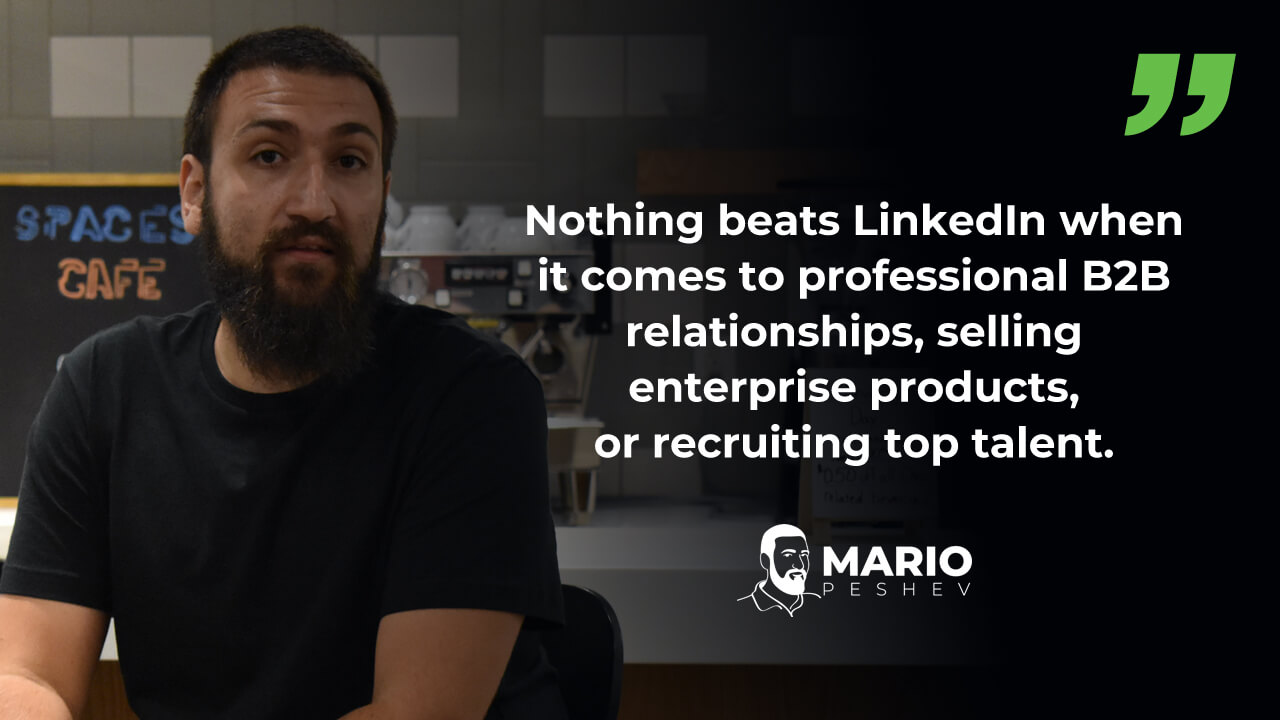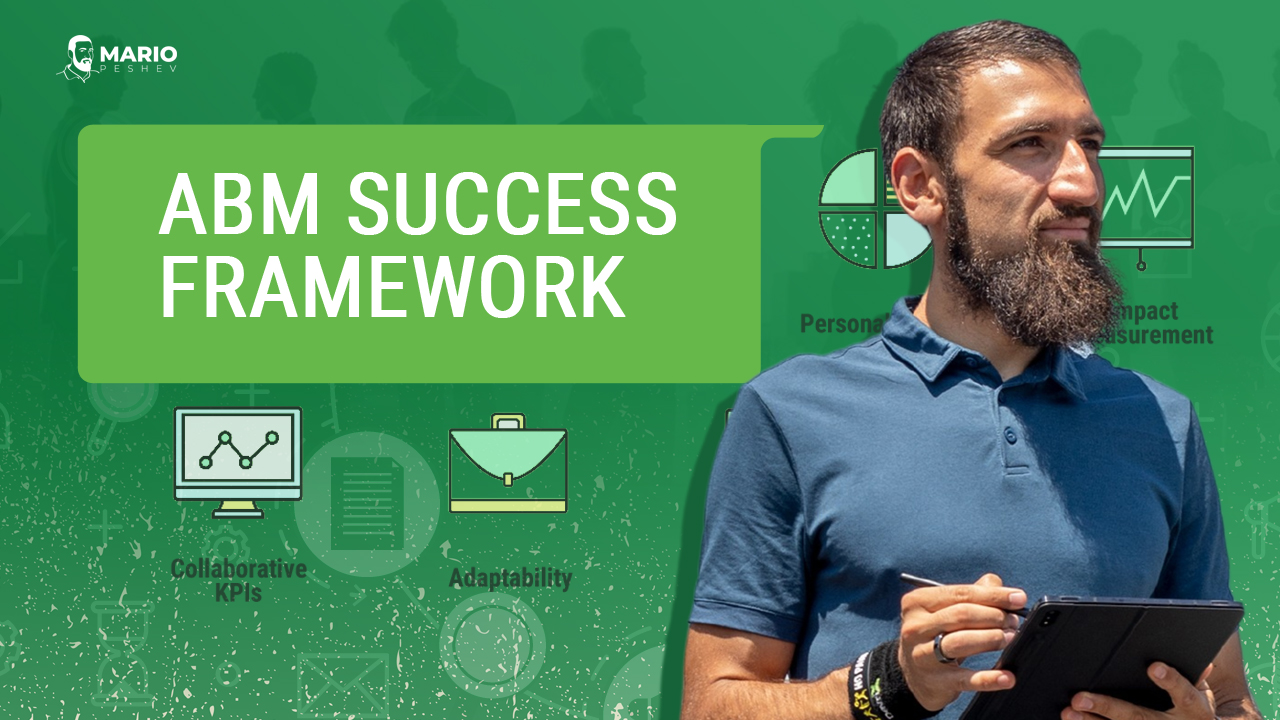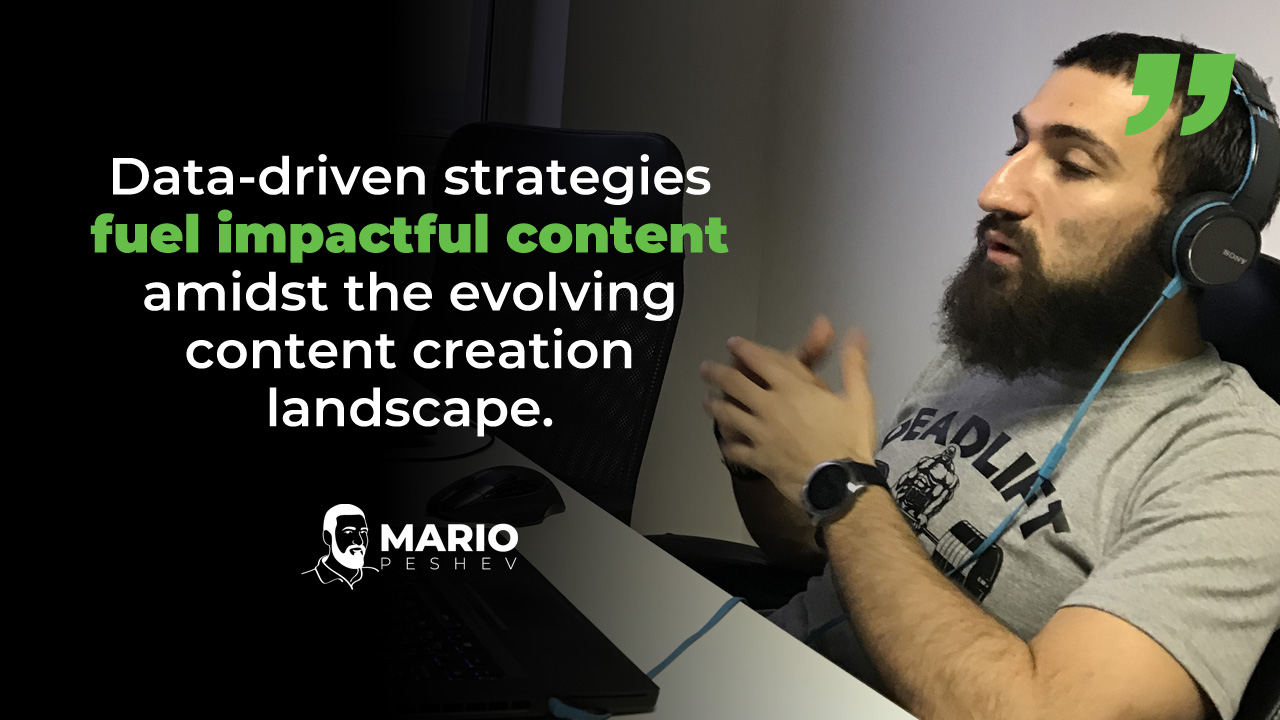Facebook or Instagram may be the leaders for B2C and direct relations to consumers, but nothing beats the strategies in marketing on LinkedIn for businesses when it comes to professional B2B relationships, selling enterprise products, or recruiting top talent.
C-Suite executives represent about 1.5% of the LinkedIn population – let alone the myriad of executives, directors, senior managers.
This high-profile pool of decision-makers is the best possible target to market (if you operate in a B2B environment). And ever since Microsoft acquired LinkedIn and turned it into a thought leadership platform, B2C businesses have been reporting positive results with purely organic reach.

The LinkedIn community grew 2X since 2015.
Prior to turning into a stronger content hub, it mostly represented a CV-building platform and a recruitment paradise.
I signed up back in 2007 when the platform reported 10-20M. Nowadays, the community hosts over 900M users and there are varying reasons why they hang out on LinkedIn. In a survey that I ran on the platform, here is how people responded to the question, “What’s the main reason you’re on LinkedIn?”
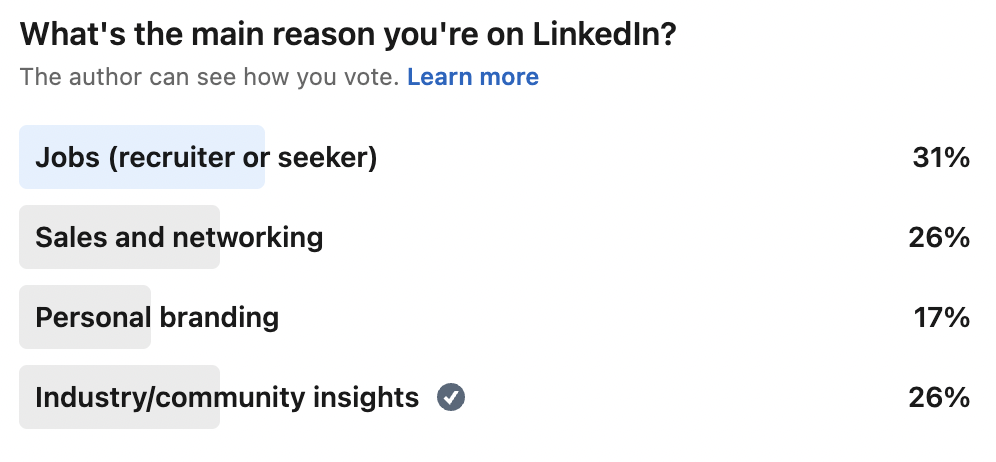
There are several reasons why LinkedIn is wildly popular among executives.
- It is a crucial marketing and sales channel. For B2B, it is the go-to place for businesses. It is one of the first spots to look up while researching a possible partner or a vendor. Executives “have” to be there.
- There are millions of small business owners and entrepreneurs. A CEO is nothing more than the captain of the ship. 89% of all US businesses employ fewer than 20 people, so tiny businesses are the vast majority of all organizations out there. Starting entrepreneurs have to grind online and you see the vocal minority as a result.
- Most LinkedIn users are not active until they have to. Almost everyone else uses LinkedIn as a recruitment/CV hosting platform. However, utilizing it as social media is still less common when compared to Facebook or Twitter.
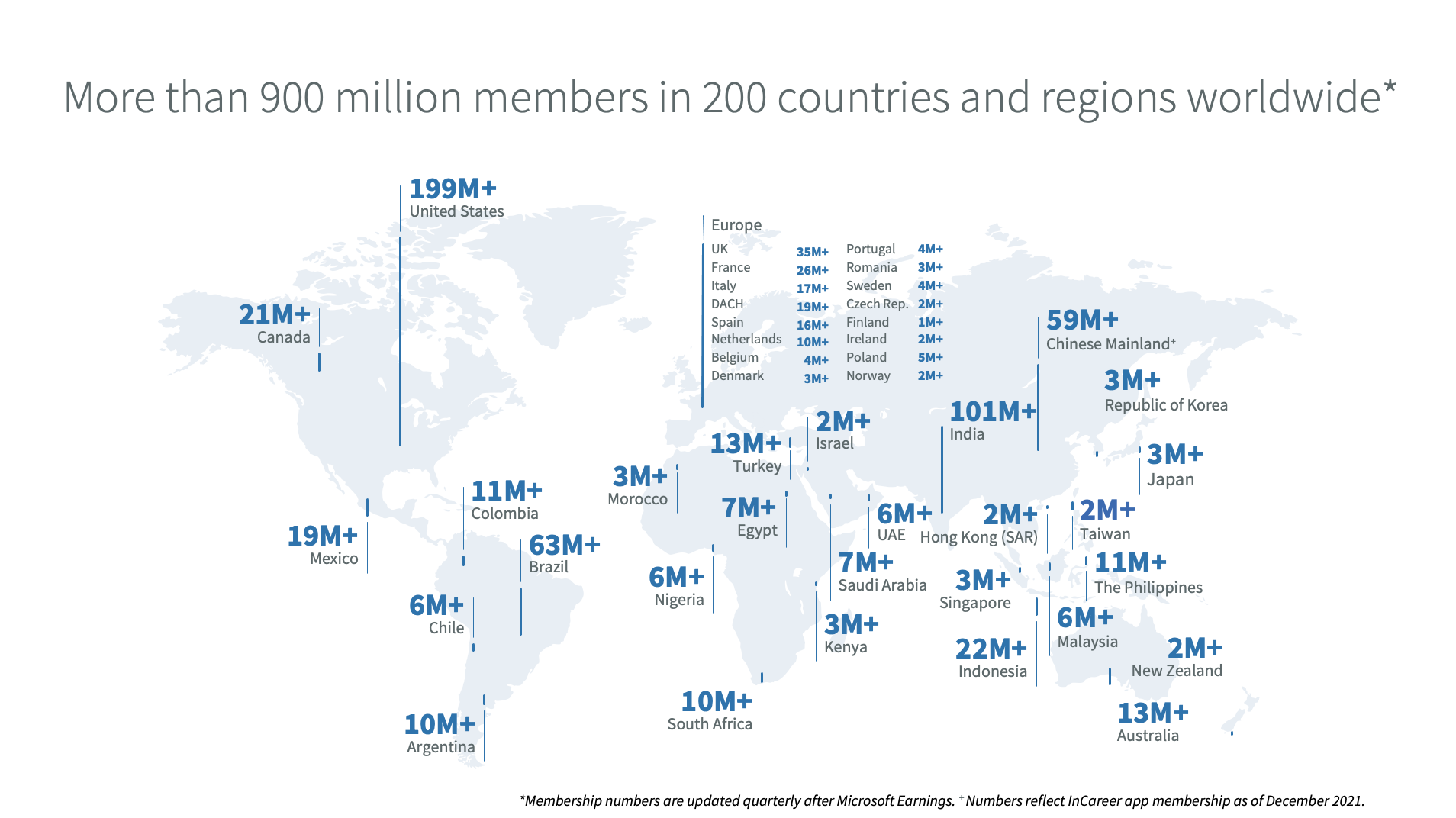
Facebook remains the leading social media. However, 80% of B2B leads come from LinkedIn.
How do you leverage such potential? First, make sure you consistently produce great content on LinkedIn.
Creating Meaningful Content on Linkedin
How do you create and post meaningful content on LinkedIn in 2023?
Based on a study, there are over 2 million posts, articles, and videos published daily on the platform. Experts recommend that you post on LinkedIn at least twice a week, but no more than once each business day. And when you post, make sure you do it in the mornings.
Others suggest that you post at least three times a week. What LinkedIn recommends is that you post every business day. HubSpot has observed that posting more than once a day results in a significant drop in engagement.
LinkedIn’s organic reach is notorious. Marketers have been thriving for the past years, constantly developing new strategies for both B2B and B2C.
Ever since Facebook practically killed all organic efforts, including millions of pages with large fanbases, LinkedIn has fully dominated the organic space.
Emerging startups can tap into your feed just as effectively as corporations like Oracle, Coca-Cola, and IBM, which suits you just fine as someone in charge of a smaller business.
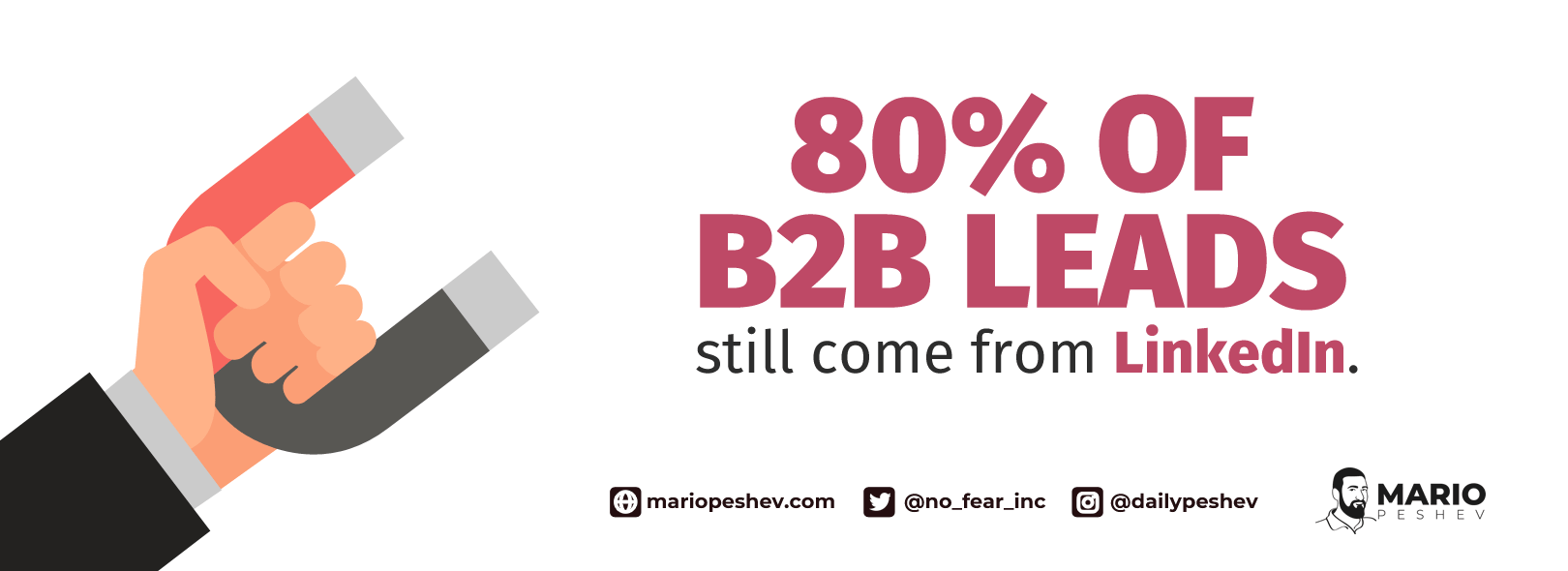
LinkedIn allows you to publish multiple forms of content which is why we will review each one separately.
Regular Posts
On LinkedIn, you have two primary ways to post the content that your members can share and distribute.
- The first one is posting standard statuses (regular posts).
- The other one is posting articles – they break down into other categories though, and we’ll cover the variations a bit later.
Let’s first start with regular posts.
LinkedIn members share their professional tips, day-to-day experiences, success stories, and even anecdotes with their connections by posting updates. This is the quickest way to stay connected with your community in a more professional manner. The posts you share will be broadcasted to the feeds of your connections and will show up on their LinkedIn homepage.
Regular posts resemble status updates on Facebook or tweets on Twitter – aside from some minor differences.
Currently, the text for posts is limited to 3000 characters, or about 500 words (on average). This makes LinkedIn posts a lot longer than tweets. The feed layout is less cluttered as well which improves readability (and engagements).
Combine that with the low number of daily posts— it is the Holy Grail of marketing.
Unlike all the spam on Facebook and Twitter, LinkedIn performs best with 20 to 30 posts a month, or up to once a day. This sets some decent order and allows you to get creative (and helpful) in your content.
Listicles work well for posts. Questions do too, along with controversial topics, and polls. Images can generate a lot of engagement in certain cases.
Articles
LinkedIn members who would like to write an in-depth post about their professional journey or the challenges they have encountered, opportunities they have seized, or an analysis of important trends in their industry, can leverage the power of articles.
Articles are longer than regular posts with up to 125,000 characters. They support some lightweight formatting which is sufficient to turn them into a comprehensive blog post with headlines, images, and video embeds.
One of the reasons articles are still actively used in marketing on LinkedIn strategies is that its internal SEO actually works.
Articles are accounted for during advanced search, add some weight accordingly and a lot easier to access (when compared to searching for an old post you published back in the day – trust me, I have been down this rabbit hole myself).
LinkedIn has been exposing public content outside of its own platform as well. Articles are well-structured and organized in your profile, accessible with a direct public link, and generate engagements over a long period of time.
Here are some things you must know about Articles on LinkedIn:
- The Articles section of your LinkedIn profile displays your original content once published.
- Your connections and followers can get notified once your articles are published and they will also be able to see your content in their news feeds.
- LinkedIn members who are not part of your network can still have access to your Articles by following you from your article. The next time you publish an article, these members will see it in their news feeds.
- Depending on your profile settings, your article may be searchable both on and off LinkedIn. If you set your profile visibility to public, your articles will be distributed publicly.
- To share it on LinkedIn, Facebook, or Twitter, click the Share icon found next to the author byline or at the bottom of the article.
- If you want to disable the ability to leave comments on your published articles, you may do so, too.
Here’s a step-by-step guide on how to write an article on LinkedIn (Source: LinkedIn)
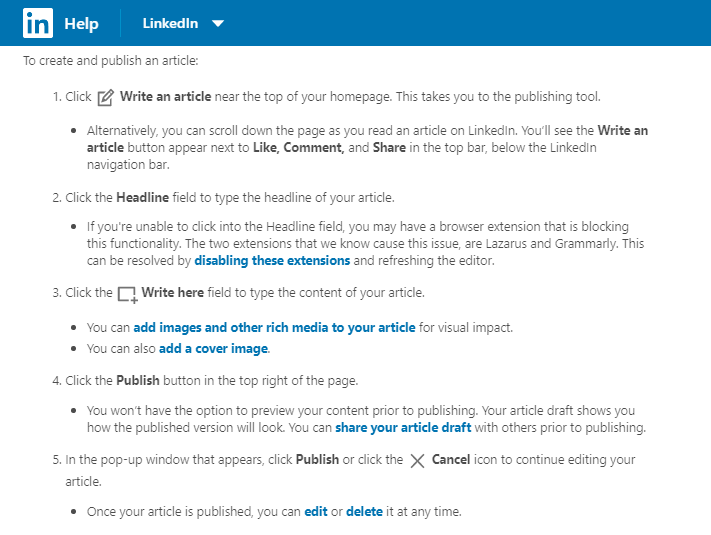
Newsletters
LinkedIn announced “LinkedIn Series” as a pilot project about two years ago and recently renamed it to Newsletters, yet the concept stays the same.
This revolutionary feature is still not open to the public as an option for showcasing LinkedIn content, but here is roughly what the editorial interface looks like:
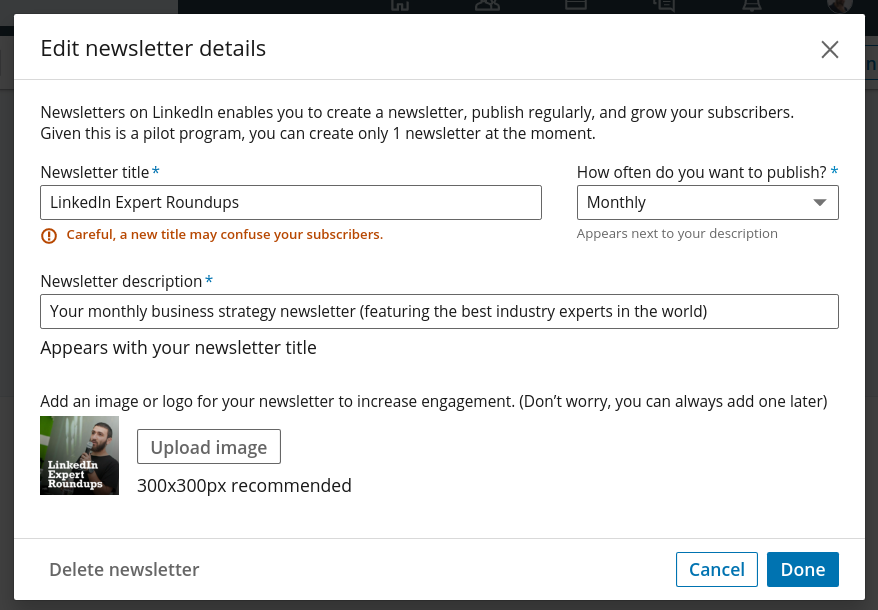
(This is my montjly roundup newsletter gathering expert opinions on various business topics.)
Instead of publishing roundups on my blog here (or on a guest column I author), I found LinkedIn to be a great place for submitting them. Tagging people is natural and sharing happens within the platform which additionally expands the reach of each story.
Newsletters are easy to author, leverage LinkedIn’s internal SEO search mechanism, tap into your own organic network, receive additional exposure through notifications, and subscribing to them takes merely a click of a button.
Combine this to the cumbersome process of signing up for a newsletter, with all legal constraints, checkboxes, double opt-in…
Newsletters are a brilliant marketing tool for gathering actual subscribers on LinkedIn. There is virtually no alternative in any other social network now (unless you take into account Medium subscribers).
For now, however, Newsletter authors are selected by invitation only and LinkedIn is currently not accepting applications to write a Newsletter.
The feature is already rolling out in stages, so you better be prepared to leverage it as soon as possible.
Videos
Marketing on LinkedIn using videos were really, really strong in marketing reach in late 2017 to mid-2019. Their organic reach is notably lower, but it is going strong for larger audiences and more entertaining/controversial topics.
More importantly, LinkedIn has been experimenting with Live for quite some time now. The drawback of Live streaming to date is the lack of a native application that supports this feature.
Luckily, there are several third-party services that integrate into LinkedIn, and once you gain access, you can tap into the LinkedIn crowd and get the right type of attention.
The following are just some of the third-party tools LinkedIn recommends:
- Socialive
- Restream.io
- Wirecast
- Switcher Studio
- Wowza Cloud
- StreamYard
- Brandlive
- Easy Live
- Vimeo
- Live U
(I use Restream myself since I also stream to Facebook and Periscope at the same time. Until recently, LinkedIn’s comments were not streamed internally—but now they are!)
To enable LinkedIn Live for your marketing campaigns or thought leadership initiatives, you must apply to be a LinkedIn Live broadcaster.
Once approved, you will get a notification that you may already start broadcasting live in your personal profile or your company’s page. Note that the use of the above-mentioned tools may incur costs, although you can start with free trials especially if you are still testing out.
Here’s a sample snapshot of me using Restream.io on topics relevant to remote working in COVID Times.
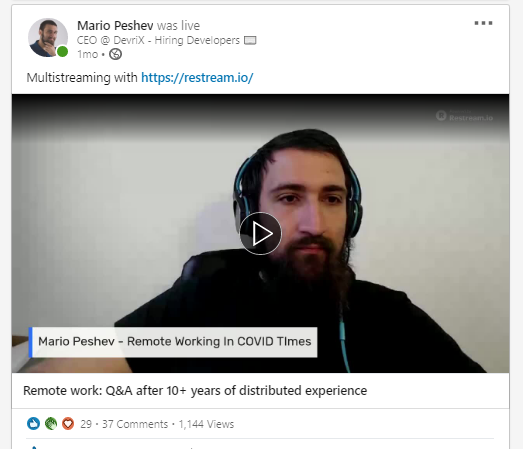
And again, regular videos (posted natively) still work well in certain industries.
Using different content formats is often a smart strategy if you target multiple marketing personas.
Some content creators are extremely successful with their video content. If you are more comfortable recording video than writing, definitely consider the native video publishing feature.
The current native limit is 10min which is about 10x the duration of an Instagram video (outside of IGTV, which has no limit). It leaves a lot of room for creativity, and uploading captions is also supported, though not as intuitive as YouTube.
Slides
LinkedIn revealed presentations near the end of 2018 or early 2019.
You have probably seen these in the form of galleries across Facebook or Instagram (and they receive some decent attention there). But slides on LinkedIn are flexible; you can upload an entire PDF slide deck or a Word file and the platform will embed it thanks to the native integration of another LinkedIn-owned platform, Slideshare.
Ever since the reach of organic video declined, slides have proven to be a great medium for content creation on LinkedIn.
Just recently, one of my slides decks reached up to 100,000+ views!
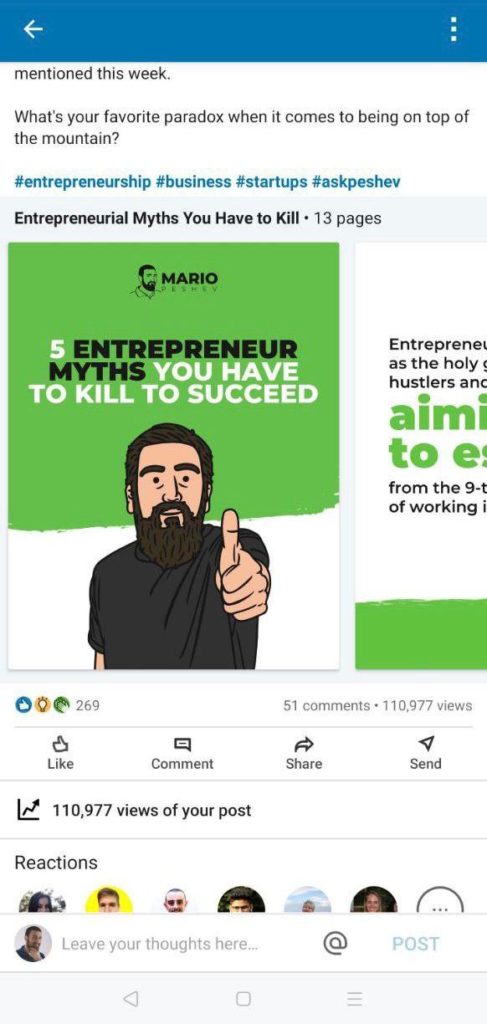
There is an estimate of 70 million unique SlideShare reaches per month. You are missing out a lot if you’re still not using SlideShare content on LinkedIn. And if you’re building a marketing strategy for LinkedIn, designing presentation decks or working on ebooks is probably something you already do in-house.
As you can imagine, doc files and presentations can contain almost anything in terms of text and media (unlike the formatting limitations of standard posts). It is up to your own strategy (and familiarity with your audience) to create powerful and helpful content that generates enough or more traction.
Slides are my most favorite LinkedIn feature right now. Content creators upload anything from user manuals to comic strips to ebooks or business presentations.
Engagement is super high and slides are unexpectedly underused.
Stories
Stories finally has made it to LinkedIn as the latest addition to the type of posts you can publish on LinkedIn.
LinkedIn Stories are just like Instagram Stories that allow users to share images or videos which can be very helpful in showcasing your professional moments, experiences, and insights. These are all essential in building a relationship that is vital in a professional online community like LinkedIn.
Here are some notes to remember when leveraging Stories:
- The Story feature is only accessible via theLinkedIn mobile app (latest version)
- Stories only last up to 24 hours.
- You can only view the Stories of your connections or pages you follow.
Here are some Story ideas you can try:
- Q&As
- Announcements
- Client testimonials
- Product promotions
- Snapshots about your daily work
- Inspirational or insightful quotes
- Quick polls or surveys
In order to make the most of each Story, make sure that you:
- provide value to your target audience
- encourage engagement
- increase awareness of your brand
Neil Patel pointed out in his guide to LinkedIn stories that if you follow the same thought process on Instagram, 25% of users swipe on stories that are branded which may not result in a direct sale, but will certainly boost brand awareness.
There are certain “best practices” you should consider when it comes to your marketing strategy on LinkedIn.
Posting With Links or Without Links
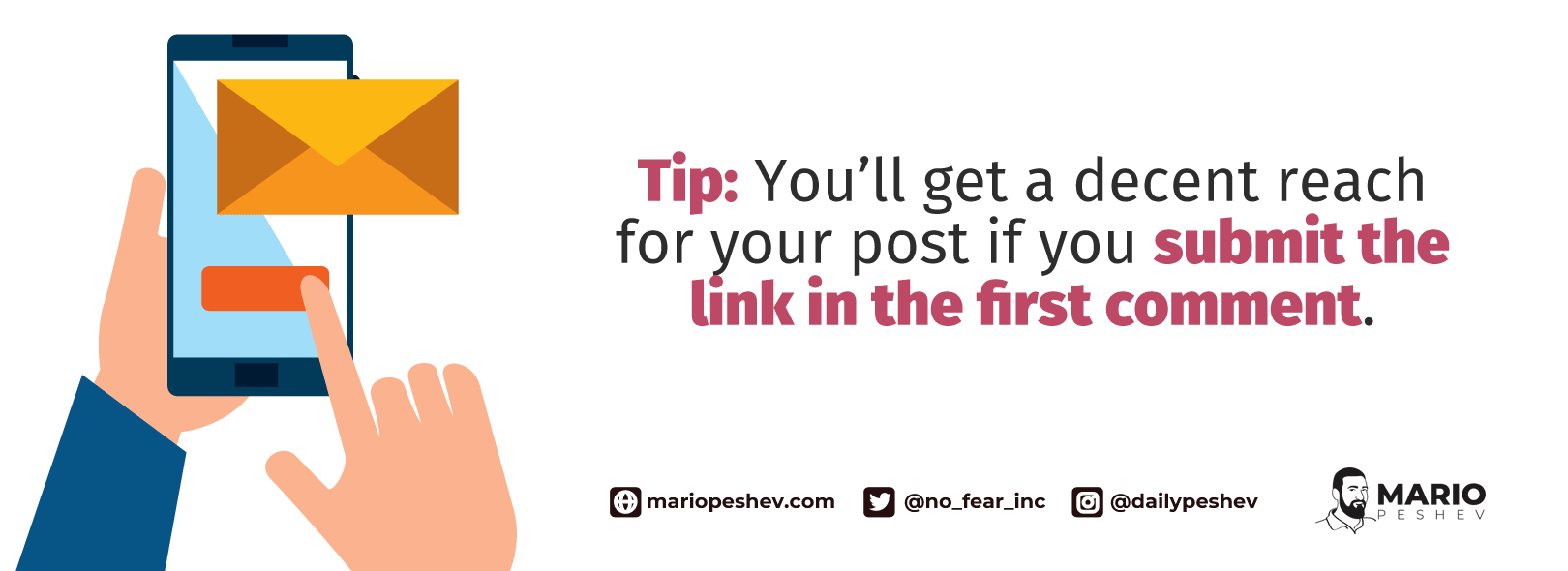
Several LinkedIn members have observed that LinkedIn posts with links don’t get as many views as those LinkedIn posts without links do.
The same reach reduction is valid for other networks such as Facebook. That’s why links within Instagram are almost prohibited (except for the bio).
Social networks don’t benefit from sending traffic away from their platforms (for free).
They want to retain people on their platforms for as long as possible.
LinkedIn offers articles for many years now and introduced videos in 2017. So far, video archives aren’t available, but they are constantly working on new features, thus the advent of Newsletter, among others.
Theoretically, users can spend hours browsing profiles, reading articles, commenting on their feed, DM’ing, posting videos, and interacting with others. Sending people to 3rd party sources likely won’t bring them back immediately once they bounce, thus the limited reach for posts including links.
So here’s a tip: You’ll get a decent reach for your post if you submit the link in the first comment. Less prominent than usual but still a better alternative for hitting marketing KPIs on LinkedIn.
Using LinkedIn’s Reaction Buttons
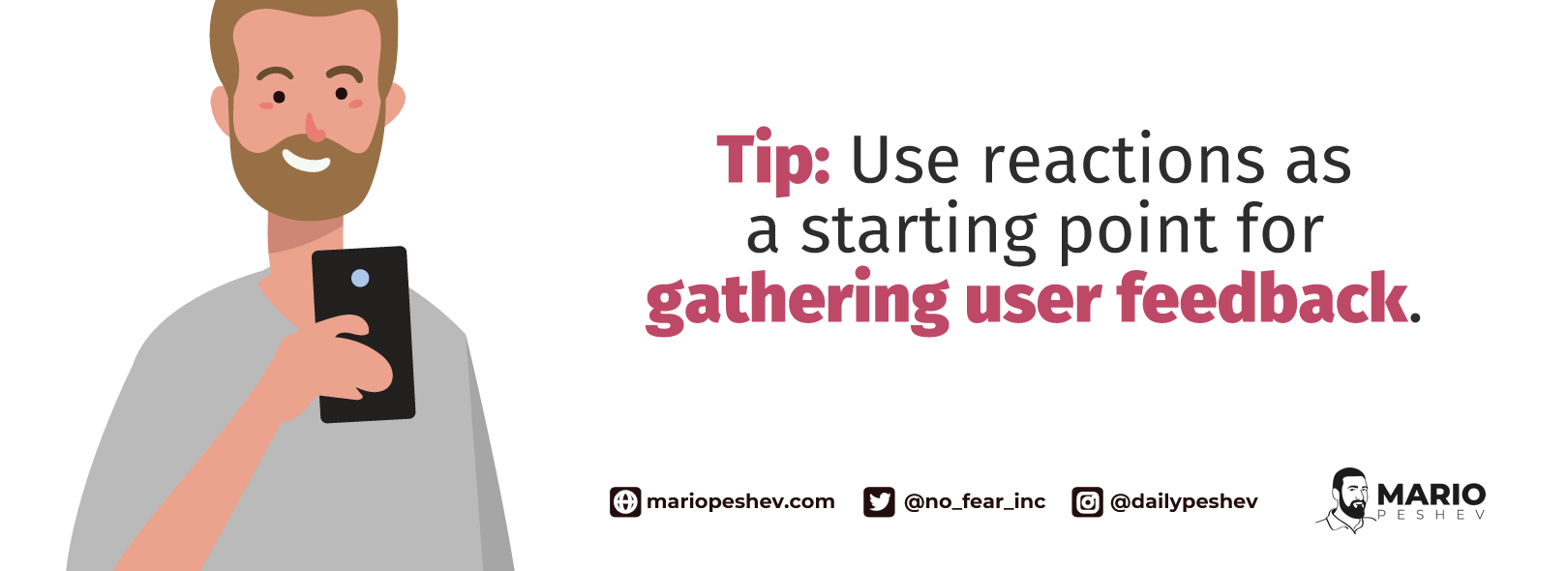
LinkedIn reactions buttons offer members to participate in conversations and communicate with their network through their expressions. The main purpose of this is to have additional engagement, relatability to the younger audiences, and follow a successful model after Facebook introduced this back in the day.
On top of that, several reaction buttons allow for indicating different signals that a “Like” is not always suitable for. A feeling of support in a tough moment won’t match the definition of “like”.
Also, tagging content across different categories (voted by users) may further be used from machine learning algorithms to classify and categorize posts in your stream in a better way.
Here’s a tip: Use reactions as a starting point for gathering user feedback. There are several tools out there that allow you to analyze how specific content performs over the others in terms of engagement via reactions. Or even without the use of these tools, you can create your own informal polls or surveys and get more chances of response from asking for simply clicking on reaction buttons.
Signing up for a Premium LinkedIn Account

Premium LinkedIn members have access to everyone who visited their profile. It even contains information regarding the type of search conducted or rather the landing page leading to your profile.
For regular users, limited information is available – like the type of positions/roles or location recent users share.
LinkedIn doesn’t want to reveal all the data they sell in their paid plans, which is why this is the type of upsell which converts better. You know for a fact that someone was browsing your profile, and even got the partial context, but their complete profile isn’t available until you upgrade.
So if you want to find out who viewed your profile and more information about such viewing, signing up for a premium account is the way to go.
There are several different “tiers” of premium accounts and access isn’t really cheap. But in the grand scheme of things, if you plan to use LinkedIn for business, it’s a legitimate business expense. Both Sales Navigator and Recruiter provide powerful tools for lead generation or headhunting.
Writing “Viral” Posts
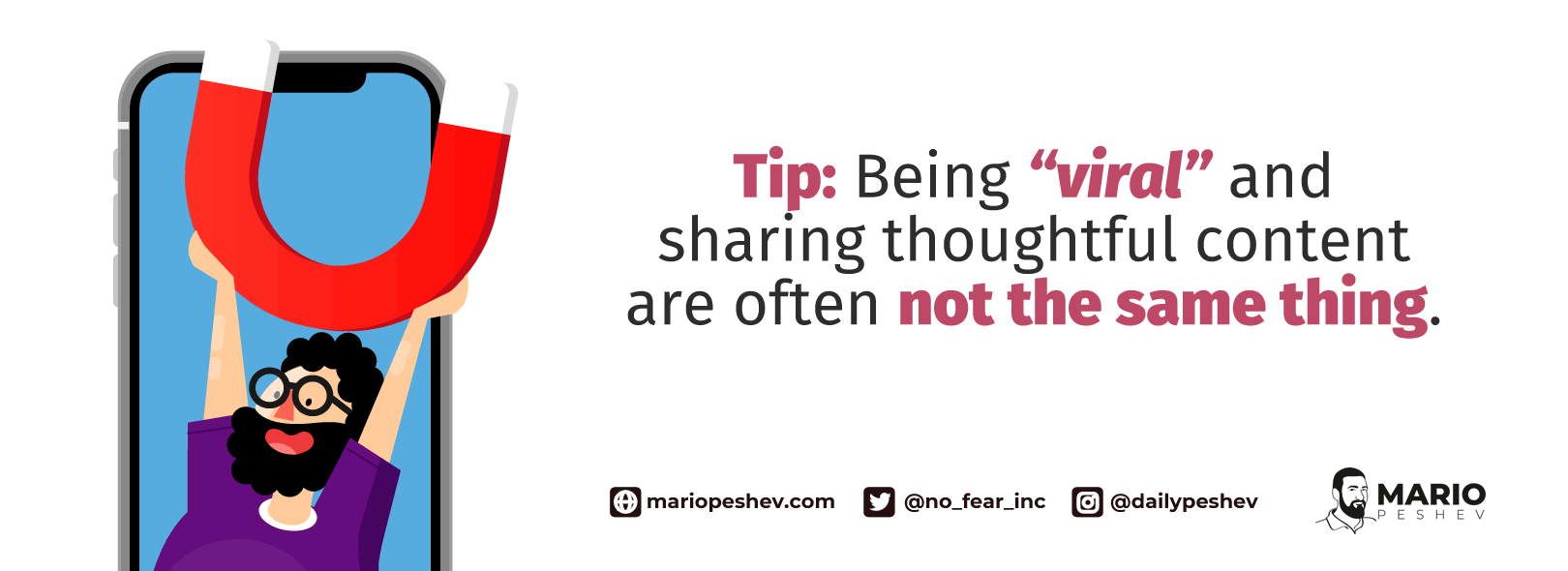
My feed is flooded with the “modern way of writing LinkedIn posts” – especially by B2C marketers.
Most viral posts appeal to emotion and they are usually controversial topics. This can be a slippery slope because authenticity may be sacrificed.
If you haven’t seen your LinkedIn feed lately, it’s likely that most of your “influential” friends have adopted this way of communicating with short sentences, one at a line. Stories are usually about a big entrepreneurial win or, more often, a failure that turned into an outstanding life lesson.
Think of the thoughtful and inspirational “good morning” quotes on Facebook or deep quotes by Einstein and co embodied into a square picture on Instagram or Twitter.
I see that recurring misbehavior by people that I respect and follow – or at least used to.

This form of storytelling is probably great when I purchase a book for the weekend by a respected author known for that kind of writing style. Otherwise, I see little to no sense in investing actual know-how and experience into bland stories on LinkedIn.
The reason I usually don’t like traditional “storytelling” is noise. A lot of people are doing the same thing these days.
Most of the time, those who bite on these types of posts are rarely composed of decision-makers. It slightly resembles the audience of viral websites and cute pet videos. A great bunch if you can sell, otherwise the brand is impacted.
Unless you have a widely popular brand or you are among the top celebrities and world-known CEO, you can share anything and many will find your post insightful. Otherwise, it’s basically friends and family, but then, those posts are for Facebook.
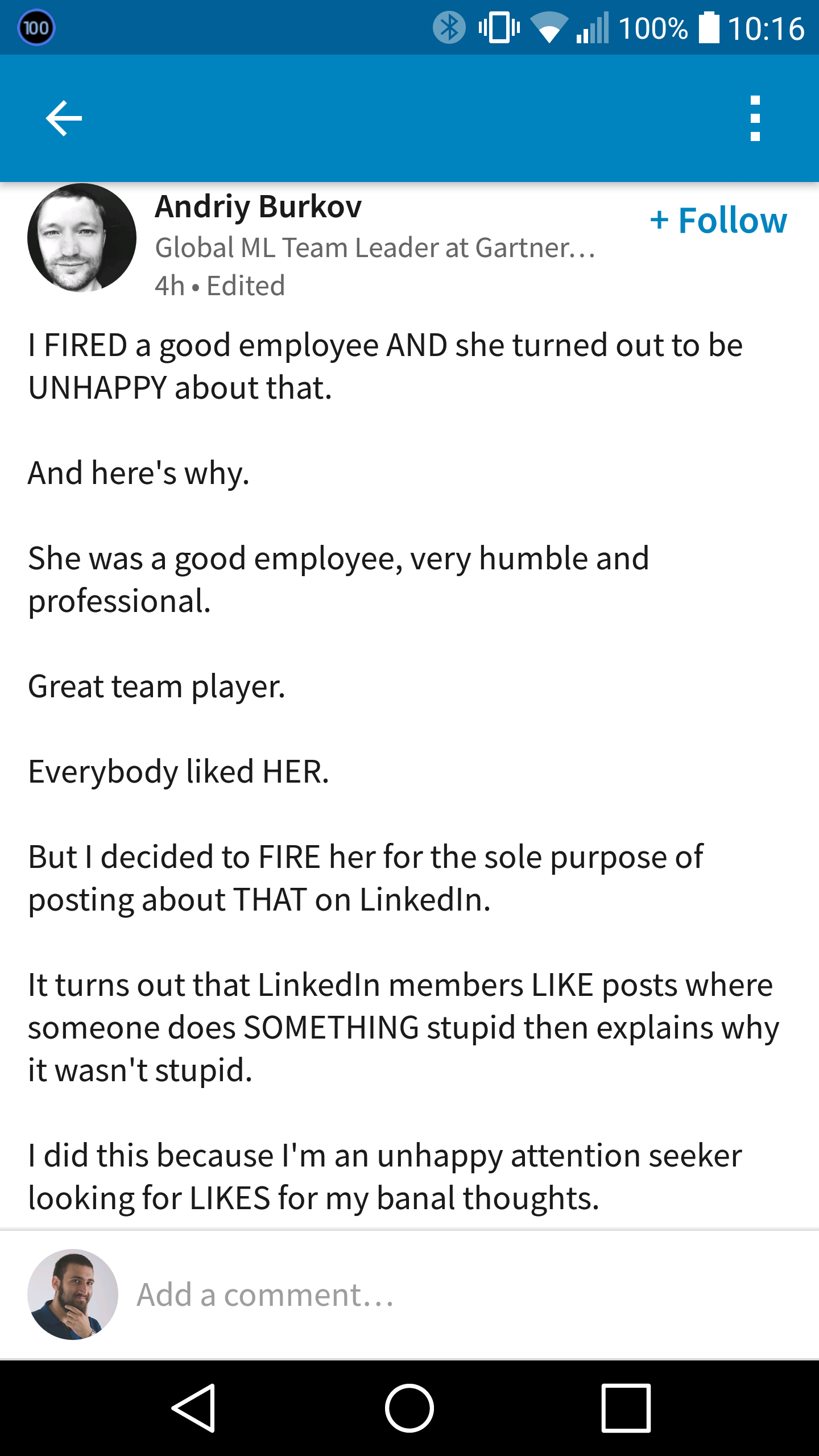
That humorous description of what happens in LinkedIn is precisely what I think of it myself. As you keep scrolling through some of the random screenshots I took, you’ll likely reach the same conclusion.
Knowing what sort of leads you are looking for matters. If your customer base doesn’t follow these stories due to time constraints in running successful businesses, then keep away from using writing these types of posts.
The thing is, being “viral” and sharing thoughtful content are often not the same thing. Sure, I could adopt that writing style, but I’d be outright embarrassed and this would actually impact my lead generation on Twitter (which has been fairly decent even without doing outreach myself).
There’s a more elegant way to share your life story, if you feel like it, without going through the hoops of writing emotionally-driven content on a regular basis that doesn’t attract new readers.
With that in mind, storytelling can work as a part of your LinkedIn marketing strategy. I follow a good chunk of folks who are not as active on LinkedIn and contribute to the most established digital outlets. They keep writing engaging content that’s emotional, inspirational, exciting, and educational at the same time.
But I firmly believe that the popular format nowadays is far from what generates a high-quality network.

Get personalized leadership advice and monthly goal assessment
LinkedIn Is THE Business Network
LinkedIn is surprisingly underutilized when it comes to both thought leadership and lead generation.
Sure, Facebook is still perceived to be the go-to place for certain reasons:
- Their “Groups” feature is second to none
- Statistically speaking, more users hang out on Facebook than any other network
- Ads are cheaper
But there’s one thing LinkedIn offers that Facebook doesn’t:
Professional “business-casual” attention.
Even if you stumble upon Bill Gates or Elon Musk on Facebook (though I doubt they personally use the platform), they won’t be open to conducting business, reviewing startups, or watching Ted talks. On the contrary, they would most probably chat with their extended family – or even play some “Candy Crush” or “Farmville”.
LinkedIn users hang out there primarily for business reasons. Intercepting someone’s attention means they are active in “work” mode. The majority of users on LinkedIn are hustlers, too—executives, freelancers, consultants, professional employees in respectable industries.
The cohort hanging out there acts differently and, on average, represents a higher purchasing power.
And if you market to this crowd, there’s no better place than LinkedIn.
Now if you want to dive deeper into mastering LinkedIn, read my other contextual guide: The 6 Most Pressing LinkedIn Questions.

